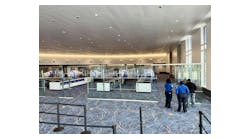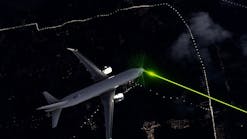The Most Common Airport Security Challenges are Manageable: Here’s How
The responsibility that U.S. airport authorities and their security services have is immense. In 2018 alone, 19,622 public and private airports handled over 16,122,000 flights and move – on average – over 44 million pounds of freight annually. This doesn’t even account for the duty airports have for keeping passengers safe and ensuring they reach their destinations on time; the average daily passenger volume was over 2.7 million in that same year, a total of 1,018,339,442 passengers for the year.
Asset protection and efficiency are the two biggest challenges for the airport industry including commercial service and all other airport categories. Airport professionals have to carefully balance passenger expectations of timeliness and comfort with a large number of potential security risks and compliancy requirements.
In airports across the U.S., security officers have a wide range of duties on both the airside and landside of the airport. They are responsible for passenger, baggage and cargo screening, perimeter fence checks, patrolling retail sections of the airport, enforcing checkpoints, and carrying out emergency plans in the case of fire, natural disaster, or civil threat. Despite all of their job tasks, they need to ensure that they comply with relevant codes and meet standards of excellence and mitigate risks while helping to keep supply and value chains moving seamlessly and ensuring tight deadlines are met the first time.
Airports in the U.S. are enlisting the resources of private security companies to help them get the job done, specifically as it relates to passenger screening. The TSA has implemented the Screening Partnership Program, which “contracts security screening services at commercial airports to qualified private companies. These companies run screening operations under federal oversight and must comply with all TSA security screening procedures. These partnerships give private firms more opportunities to assist today’s airport security teams meet the everyday security and service challenges facing them.
Common Airport Security Challenges
With so many moving parts, a large volume of people and cargo, and the need to ensure that a vast operations area meets both security and quality standards, it’s necessary to identify the challenges that are most difficult for security teams to overcome. While each airport will have its own unique obstacles, all share a combination of the following:
1. There must be zero margins for error. For both safety and logistical reasons, standards must be met during each and every security shift. The lack of flexibility with no room for failure is something that is top of mind for today’s private security teams. If even one team member falls behind, it can have a ripple effect on the entire airport operation or result in serious sanction/punishment from federal or local authorities.
2. Security has a need for real-time optimization. Security teams can always improve their processes but need access to up-to-the-minute monitoring and data to adjust how they respond to both passenger volume and flow. The gender of your passengers, for example, will determine how many female or male security staff members need to be available for enhanced screening procedures. A staffing issue, such as too few agents in a screening lane can cause bottlenecks and frustration for travelers. Knowing these issues either before or as they happen is the only way to ensure compliance and the delivery of quality of service.
3. It is a highly regulated environment. Airports don’t have much autonomy in formulating the security objectives and requirements that their security teams must meet, as federal authorities largely set these. In addition to the regulations put forth by the U.S. government, FAA, and TSA, there are additional security compliance codes that may be specific to each airport. Knowing these sometimes nuanced rules, as well as tracking them, is a significant task.
4. Airports have unique training and certification requirements. Security companies must know which of their employees are trained and certified to carry out certain key duties at particular stations or checkpoints, along with how long each security officer stays at their station and how shift changes are handled. When it comes to airport operations, personnel matters are also security matters.
5. Everything is moving. With each passing second, airport security needs to be highly flexible to meet fluid situations and requirements. The thousands of people, along with numerous security lanes, incidents, and x-ray shift rotations will always experience an ebb and flow in traffic, but need adequate coverage at all times. This requires security firms to have the capabilities from a human resource and skills perspective to respond proactively or reactively as situations develop
6. Everyone needs to be safe. Passengers are the most high-profile customers of the airport, but security teams seek to serve everyone that moves through them on both the land and airside at the airport. This includes suppliers and partners, contractors, airport employees, tenants, flight crew, and those entering the pickup and drop-off areas. The over 2.5 million daily passengers represent just a portion of those for which security maintains care.
7. We live in a digital world. The time of paper-based reports and documentation is nearing an end, and today’s security teams require more nimble solutions to their administrative and quality control benchmarks. Those who still have paper-based components of their security recordkeeping are arguably putting themselves and their airports at significant risk.
8. A record footprint is essential. Not only are security records vital for research into incidents and keeping the TSA performance criteria, but they also help to build a comprehensive history of security. Critical event monitoring and human resource compliance depend on accurate records of every login, shift change, or attempted checkpoint breach.
While there are many other aspects of airport security management that may strain security resources, these are the ones most likely to cause additional work for today’s airports. They are also the issues experienced most by private security firms working in tandem with the FAA and TSA departments at the local level.
Maintaining Security Standards and Mitigating Challenges
With so many areas to proactively manage and control, how can security teams manage it all? The sheer volume of what goes on in an airport requires nothing short of a robust set of supervisory tools and powerful oversight designed to see it all at a glance with relevant alerts built in at appropriate places. It must also track and report to ensure compliance at every step of a shift. Maintaining security standards and mitigating challenges can be achieved by:
- Creating a comprehensive view of the airport’s security status and potential risks. This is best achieved by moving the airport security officers into a fully digitalized workforce management environment. With a cloud-based solution that delivers real-time data, managers and supervisors can see their entire airport security status on a single screen, allowing them to identify potential security or customer conflicts before they become a serious issue. Security teams move from being reactive to proactive.
- Anticipating adjustments in staffing requirements. Supervisors can proactively manage sudden changes in passenger flow or needs, as well. Long waits for just the right additional personnel are cut down when a supervisor can see, at a glance, who is on the clock and available to assist with coverage. With this approach, travelers needing extra assistance or enhanced screening can be assured that personnel is ready to do the job.
- Improving field monitoring and reporting operations. Security supervisors need more than assurance that their security officers are in the proper place at the proper time. From passenger screening to luggage checks to utilization of de-escalation techniques, supervisors need the unfettered ability to inspect officers in the field to ensure they are doing tasks by the book. Reporting the findings and reviewing them regularly should be a key part to improving the overall quality of your security operations.
- Locating and dispatching officers in real-time. Airports cover large surface areas and security officers will likely be patrolling and performing duties in a myriad of locations. Supervisors can reduce risks and the margin for error by having the ability to locate their officers in real-time via GPS technology so they can instantly see where their officers are at anytime and ensure they are at their stations performing their duties. This capability allows them to immediately dispatch the nearest officer, based on proximity, to investigate an alarm, support another officer, or respond to a member of the public. Geolocation capabilities mitigate risks by enhancing officer accountability and the delivery of efficient security services.
- Meeting SLA requirements and measuring performance. For an airport, the investment in an outsourced and reliable security operation is not cheap. Airport administrators will want reassurance that the security company is delivering its services per the contract and that KPIs are being achieved. Security companies can mitigate the risk of being perceived as ‘not meeting expectations’ by having access to the right technology that continuously validates its security. This is delivered based on measurable KPIs and documentation of how risk factors are mitigated, and efficiencies are improved upon. The right software tools do more than basic security functions; they provide quality assurance tools and tie value back to the investment in private security teams.
How Advanced Solutions Simplify Operations
How might these solutions look during a typical security-screening shift? With each security officer’s profile, including current certification, human resources record (including any disciplinary reports or task limitations), gender, and training on hand each time they check into their shift, supervisors can see if there are discrepancies before they start to work. Only authorized workers will cover checkpoints, and shift changes – when needed – can happen seamlessly and without error. Stations won't be accidentally unmanned, and there's a limited possibility of doubling up or having staff report to the wrong checkpoint or lane.
Quality and Security Working as One
The technology available for private airport security companies enables teams to meet firm safety and security standards without sacrificing the comfort and free movement of passengers or interrupting supply chains. Since many travelers report experiencing stress over the baggage checkpoints and possible enhanced security screenings, it behooves security teams not to diminish the customer experience. Calm passengers are less likely to strain security resources.
Only through a balance of qualified security offers following regulations and the satisfaction of customers, will can private companies be truly proactive with airport security. Digitalized workforce management environments get us there with the fewest steps possible.





